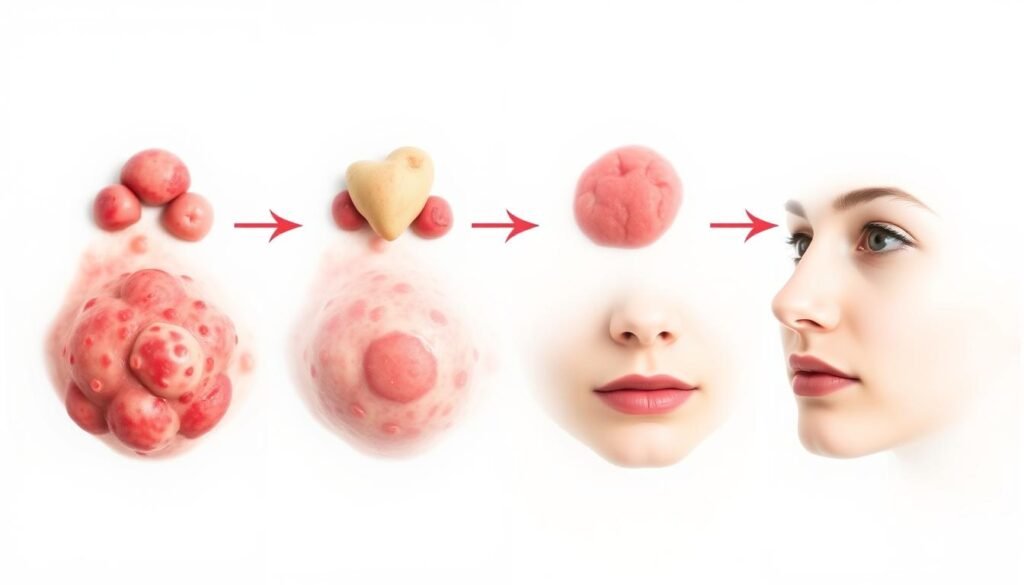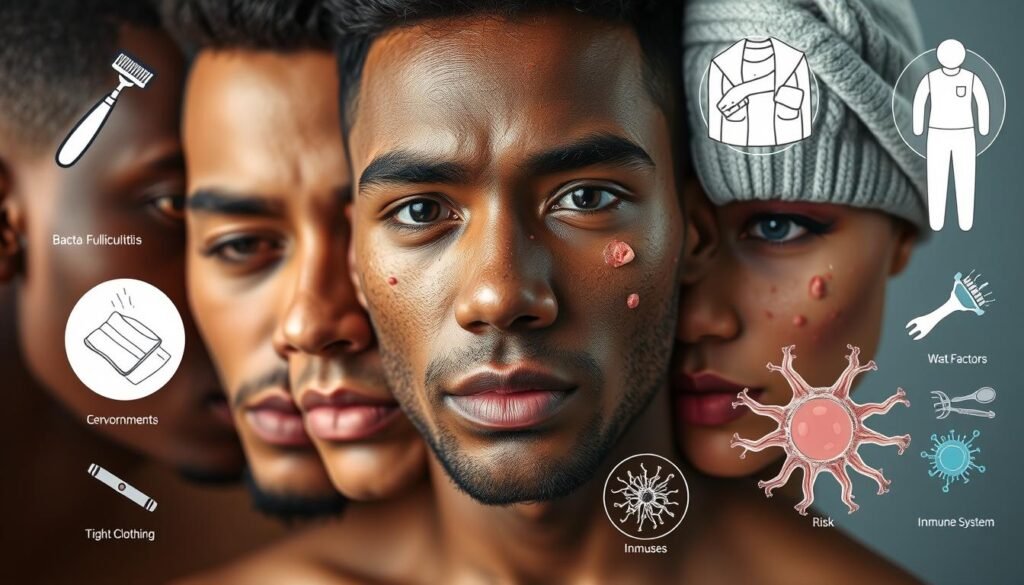About half of all folliculitis cases come from bacterial infections. Staphylococcus aureus is often the culprit. This skin issue makes hair follicles inflamed, causing from slight to severe irritation. Knowing how bacterial folliculitis heals is key to dealing with it. This article sheds light on the healing stages, guiding those affected through recovery. It also looks at treatment options for folliculitis.
Key Takeaways
- Bacterial folliculitis can arise from various bacteria, most commonly Staphylococcus aureus.
- Understanding the healing stages can aid in more effective treatment and recovery.
- Topical and oral treatments are essential for managing severe cases of folliculitis.
- Good hygiene practices can significantly reduce the recurrence of folliculitis.
- Early recognition of symptoms can lead to faster recovery and prevention of complications.
What is Bacterial Folliculitis?
Bacterial folliculitis is a skin issue that involves hair follicles. It looks like acne with small red bumps or pus-filled blisters. These can appear on the face, arms, legs, and back.
The main cause of folliculitis is a bacterial infection, mainly by Staphylococcus aureus. This infection can make the skin itchy and uncomfortable. If not treated early, it could lead to hair loss or scars. Knowing the stages of skin infection is key to prevent worse problems.
Folliculitis comes in two forms: superficial and deep. Superficial types affect only part of the hair follicle. Deep types include the whole follicle and are more serious. Wearing tight clothes can make it worse by trapping heat and moisture.
Keeping clean can lower your chances of getting folliculitis. Being aware of the symptoms helps you to get treatment early. This way, you can avoid more serious issues.
Symptoms of Bacterial Folliculitis
It’s important to spot the signs of bacterial folliculitis early. This skin problem often starts as painful, red bumps near hair. These can grow into pus-filled blisters, making you feel really uncomfortable.
Common Signs to Recognize
Here’s what to look for with bacterial folliculitis:
- Clusters of small, itchy bumps around hair.
- Pus-filled blisters that might open and hurt.
- Skin that’s inflamed and feels tender.
Swelling and redness often happen where the infection is. If you see these signs, be on the lookout for other symptoms. Things like feeling very tired or having a fever could mean it’s getting worse.
How It Differs from Other Skin Conditions
Bacterial folliculitis isn’t like acne, even though they can look similar. Acne pops up on your face and body but doesn’t focus around hair follicles. This is a key difference for figuring out what you have.
Bacterial cases often come from infections like Staphylococcus aureus or Pseudomonas aeruginosa. Unlike irritation-based issues, these need special attention. Knowing this helps you get the right treatment.
Causes of Bacterial Folliculitis
Bacterial folliculitis is caused by bacteria infecting hair follicles, which leads to swelling and pain. Knowing the causes helps in preventing and treating it. We will look into the main bacterial infections and other factors that cause folliculitis.
Common Bacterial Infections
The biggest culprit for bacterial folliculitis is Staphylococcus aureus. This bacterium can cause infection if it gets into the skin via cuts. Also, Pseudomonas aeruginosa causes hot tub folliculitis, found in poorly kept hot tubs. These examples show why clean living and good hygiene are key to avoiding folliculitis.
Other Contributing Factors
- Tight clothes can block air flow and hold in moisture, making it easy for bacteria to grow.
- Hot tubs can cause folliculitis, especially if not enough chlorine is used.
- Shaving the wrong way can irritate skin and cause ingrown hairs, which makes folliculitis worse.
- Certain skin conditions and irritants can make you more likely to get infections.
- People with weaker immune systems might get infections more often, showing the link between health and skin problems.
Knowing these factors helps us see how important it is to prevent and treat skin infections. By understanding what causes folliculitis, we can choose the best ways to protect our skin.
Bacterial Folliculitis Healing Stages
It’s vital to know the healing stages of bacterial folliculitis for good skin care. This condition heals in four main phases. Each phase has its own symptoms and needed care.
Stage 1: Initial Inflammation
At first, you’ll see redness and feel soreness where infected. This shows as small, painful bumps. This is how your body fights the infection.
Stage 2: Development of Symptoms
Then, itching and pus-filled blisters start to show up. This means the infection is getting worse. These signs often suggest you might need treatment soon.
Stage 3: Pustule Formation
Pustules form as swelling increases in the hair follicles. They might break open, which can lead to crusting. Keeping clean is key to stop the spread.
Stage 4: Healing Process
This last phase is when healing truly begins. Pain and discomfort start to go away. Understanding these stages helps you manage symptoms better and know your condition well.

Treatment Options for Folliculitis
Treating folliculitis depends on how severe it is and what type. It’s key to know your options to find the best solution. This knowledge helps heal and manage folliculitis effectively.
Topical Treatments
Topical treatments usually start the fight against folliculitis. They can lower inflammation and bacteria. People who want to avoid scars from bad outbreaks find them useful.
Oral Medications
Sometimes, severe cases need oral antibiotics. These drugs fight the infection from inside. Always talk to a healthcare provider before starting any meds to make sure they’re right for you.
Natural Remedies
There are natural ways to fight folliculitis too. Warm compresses can ease pain and speed up healing. Maintaining good hygiene helps prevent more problems. Natural methods should work alongside medical treatments to make your skin better. Read more about natural care at treating folliculitis naturally.
| Treatment Method | Description | Use Case |
|---|---|---|
| Topical Treatments | Antiseptic and antibiotic creams | Mild cases of folliculitis |
| Oral Medications | Systemic antibiotics | Severe or persistent cases |
| Natural Remedies | Warm compresses, proper hygiene | Complementary treatment to reduce irritation |
Home Remedies for Folliculitis
Home remedies for folliculitis are effective for easing symptoms and healing. Natural treatments provide many people with comfort. Adding simple practices to everyday life helps recovery and stops more irritation.
Warm Compresses
Putting warm compresses on sore areas helps a lot. It drains pus and eases irritation. Keeping a warm cloth on your skin for 20 minutes a few times a day helps a lot. Most people find these methods work well, with 70-80% finding relief from mild folliculitis.
Hygiene Practices
Good hygiene is essential in treating folliculitis at home. Wash gently with antibacterial soap twice a day to avoid worsening the infection. Drying with clean towels and wearing loose clothes helps heal without friction. Sticking to these hygiene habits, many see a 90% improvement in their symptoms. Keeping up with these practices is the secret to lasting recovery.

How to Prevent Bacterial Folliculitis
Preventing bacterial folliculitis is about changing habits to lower risks. Knowing what causes it from environments and habits is key.
Avoiding Risk Factors
Some habits greatly raise your chances of this skin issue. Below are tips to lessen these risks:
- Practice good hygiene: Washing areas with soap and water keeps skin healthy.
- Avoid tight clothing: Snug clothes can irritate your skin and trap heat.
- Be cautious in communal settings: Places like public pools and shared razors can have bacteria. Try to stay away from shared items when you can.
- Take care of cuts and wounds: Cleaning and covering any skin breaks help keep infections away.
Long-term Skin Care Tips
Using good skin care habits for a long time helps prevent folliculitis. Here’s what you should do:
- Daily shampooing: Washing your scalp often prevents blocked follicles.
- Maintain skin dryness: Dry skin reduces chances of bacterial growth, mainly in wet areas.
- Proper shaving techniques: Clean razors and shaving with hair growth minimizes skin issues.
- Stay informed: Knowing different types of folliculitis helps spot symptoms early. Check out this guide for more info.
| Prevention Strategy | Description |
|---|---|
| Good Hygiene | Regular washing with soap and warm water. |
| Avoid Tight Clothing | Reducing friction and heat increases skin comfort. |
| Safe Communal Practices | Avoid using shared razors; be cautious in public pools. |
| Daily Scalp Care | Shampooing regularly to maintain clean hair follicles. |
When to See a Doctor
Knowing when to see a doctor for folliculitis is key to handling it right. You should watch how your symptoms are doing. If they don’t get better after a week or two, even with home care, it’s time to get help. Seeing a doctor early can help avoid worse problems and heal faster.
If the infection gets really bad, you need to act fast. Signs like more redness, a lot of pain, fever, or feeling sick overall mean you should see a doctor right away. This step is crucial to get the right treatment quickly.
Usually, taking care of yourself at home should start making things better in a few days. If you don’t see any improvement after 2-3 days, it’s wise to see a doctor for folliculitis. If you’re already on antibiotics and things aren’t getting better, you might need to see your doctor again.
If you keep getting folliculitis, getting checked out by a professional is a good idea. Figuring out why it keeps coming back can help make a plan that stops it from happening again.
| Symptoms | Action |
|---|---|
| Persistent symptoms for over 1-2 weeks | Contact a healthcare provider |
| Severe redness, pain, or fever | Seek medical attention immediately |
| No improvement after 2-3 days of care | Return to the doctor |
| Recurrent infections | Request further evaluation |
Complications of Untreated Folliculitis
Not treating bacterial folliculitis can lead to big problems. People should know about the potential complications of folliculitis. It’s important to catch it early. This helps avoid major issues and keeps skin healthy.
Potential for Scarring
Scars are a big worry with untreated folliculitis. Up to 30% of people with it might get permanent scars. Bad cases can also lead to hair loss.
Recurrent Infections Risks
Untreated infections can keep coming back. This makes it harder to treat the skin problem. In about 20% of cases, the infections get worse. Around 15% might get painful boils that need more care. For more info, check this detailed resource.
Who is at Higher Risk for Folliculitis?
Some people are more likely to get bacterial folliculitis. This includes those with weaker immune systems, diabetes, or skin issues like dermatitis. Key factors that make someone more susceptible include:
- Individuals with weakened immune systems: They can find it hard to combat infections.
- Those with diabetes: High blood sugar can harm your skin and raise infection risks.
- Frequent shavers: Regular shaving, especially for those with curly hair, increases the chance of folliculitis.
- Children: Kinds prone to skin infections or on IV meds are more likely to face folliculitis.
- Environmental factors: Poorly maintained hot tubs or pools can greatly increase infection chances.
- Individuals using antibiotics: Long-term use of antibiotics can change skin bacteria, leading to issues.
- Hot, humid conditions: Tight clothes or lots of sweating make folliculitis more likely.
Knowing these risk factors helps people act in advance to lower their risk of getting this tough skin issue.

Understanding Other Types of Folliculitis
Folliculitis comes in many forms, each with its own causes and symptoms. Knowing these types is key to treating them well. Among them, pseudofolliculitis barbae and hot tub folliculitis can cause a lot of discomforts. They can even lead to more issues if not treated.
Pseudofolliculitis Barbae
This condition is often seen in people with curly or coarse hair. It happens when hairs grow back into the skin, causing inflammation. It’s most common in areas shaved often, like the face. The symptoms can include painful bumps and skin irritation. To help the skin heal, it might be good to stop shaving for a week or so. A good skincare routine can help control it and prevent it from coming back. If you’re having trouble, a dermatologist can offer specialized treatments.
Hot Tub Folliculitis
Hot tub folliculitis comes from a germ called Pseudomonas aeruginosa. This germ grows in water that’s not clean, like in some hot tubs and pools. Symptoms, like itchy, red bumps, show up a day or two after exposure. They can turn into small, pus-filled spots. Usually, this goes away on its own in a couple of weeks. Keeping clean, like showering after swimming, can help avoid it. It’s also smart to not shave right before you get into the water.
| Type of Folliculitis | Common Causes | Symptoms | Prevention Tips |
|---|---|---|---|
| Pseudofolliculitis Barbae | Ingrown hairs, often after shaving | Painful bumps, inflammation | Avoid shaving for 7-10 days, maintain proper skincare |
| Hot Tub Folliculitis | Pseudomonas aeruginosa in contaminated water | Itchy red bumps, pustules | Shower after swimming, avoid shaving beforehand |
If you want to learn more about treating types of folliculitis, like pseudofolliculitis barbae and hot tub folliculitis, check out this informative guide.
Living with Folliculitis
Having folliculitis can be hard for many people. It’s crucial to know how to handle it for healthy skin. This skin issue can appear in different ways. For example, superficial bacterial folliculitis usually gets better on its own in a few days. Checking your skin regularly can spot any problems early.
Knowing what causes your skin flare-ups is key. For example, poorly maintained hot tubs can increase infection risk. People with weaker immune systems or those who are overweight might face more challenges. This makes it clear how important it is to prevent these problems.
- Use soft cleansers and medicated soaps recommended by skin doctors.
- Steer clear of hair removal methods that irritate the skin, letting hair grow back healthily.
- Keep an eye on your skin to spot any problems early and get advice from doctors right away.
- Keep up with good cleanliness to lower infection chances.
To sum it up, handling folliculitis well means being careful with your skin care and life choices. By understanding the issue and taking action, people can live well and comfortably.
Conclusion
Knowing how healing stages of bacterial folliculitis work helps you get better. This condition is mostly caused by bacteria like Staphylococcus aureus. There are many treatments available, from creams to procedures like laser therapy.
To stop it from getting worse, it’s important to spot the symptoms early. Doing this helps avoid scars or the infection coming back. Keeping clean and using the right skincare products is key to improving.
For more info, you can find a thorough look at treatments and outcomes here. It’s also good to know how diet and lifestyle impact your skin’s health for better recovery.
If you’re facing folliculitis, being well-informed can improve your skin and well-being. Having full knowledge of the healing stages of bacterial folliculitis guides you to the right treatment. It helps you make smart choices for your skin’s health.
